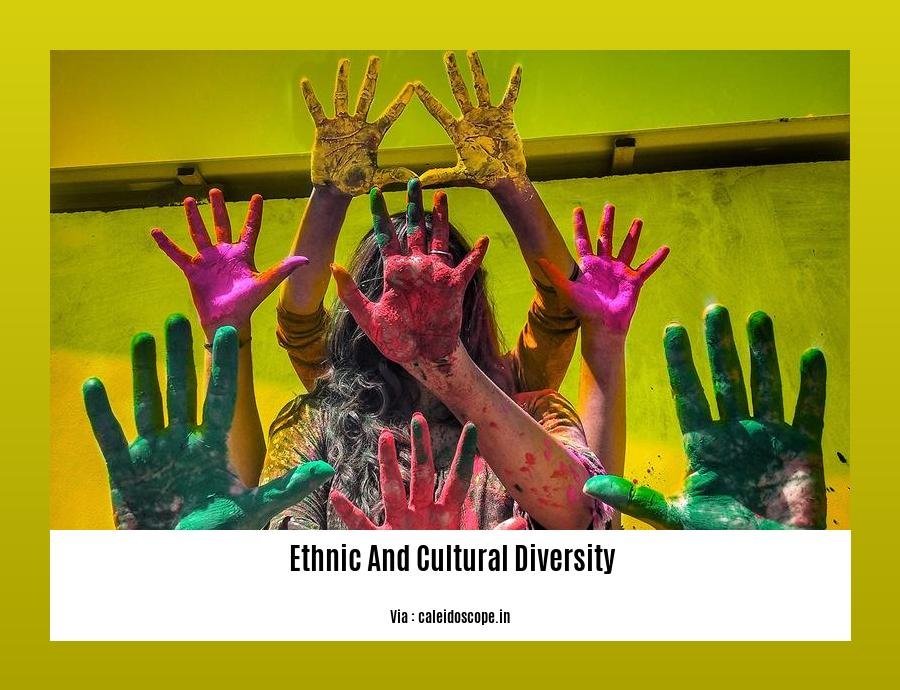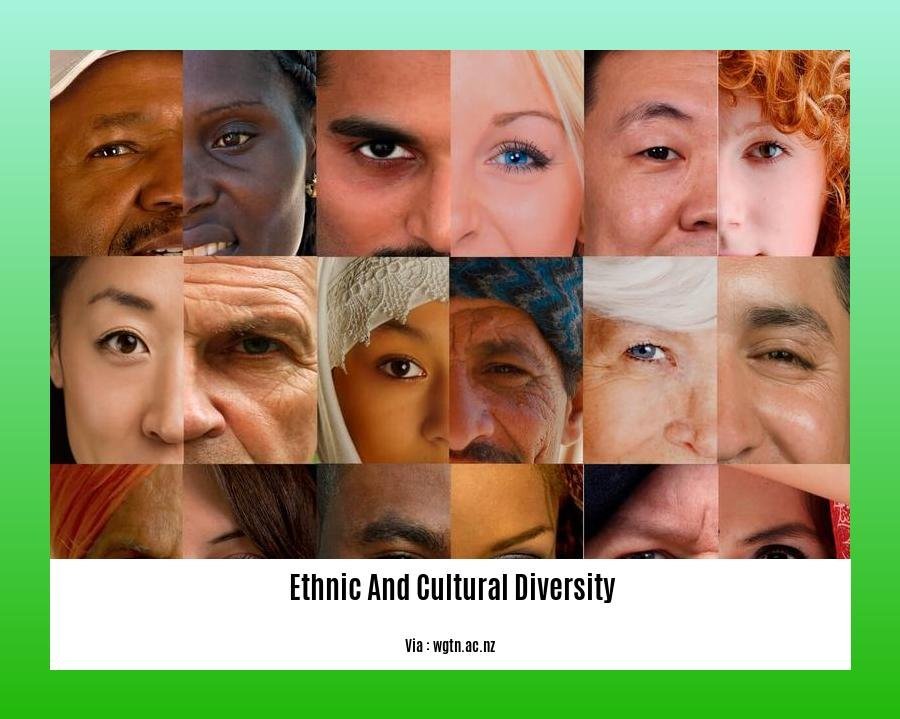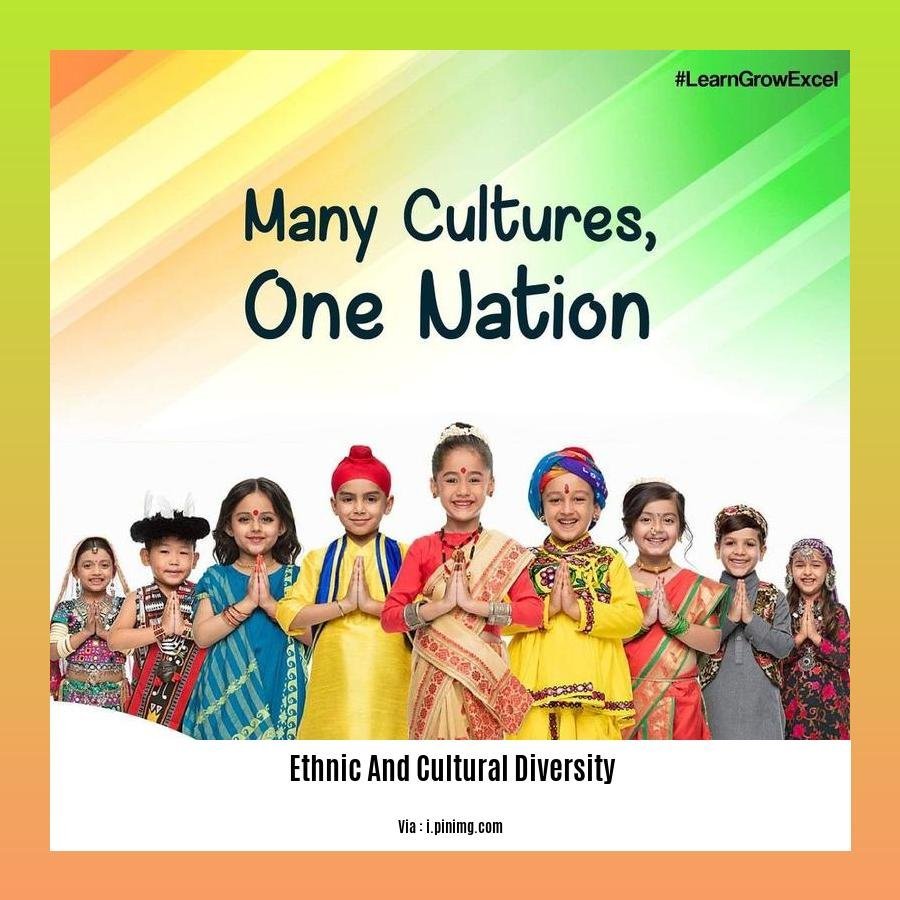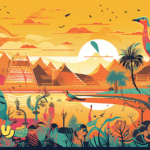In the tapestry of our world, the vibrant threads of ethnic and cultural diversity intertwine to create a rich and complex pattern. This heterogeneity presents both challenges and opportunities, shaping the fabric of our societies and influencing our experiences in profound ways. As we explore the tapestry of ethnic and cultural diversity, we delve into the intricacies of human connection and the beauty of difference, recognizing that unity can emerge from diversity, and harmony can be found in the embrace of all cultures. [Exploring the Tapestry of Ethnic and Cultural Diversity: Challenges and Opportunities in a Heterogeneous World]
Key Takeaways:
- Cultural diversity enriches society and drives creativity, innovation, and economic growth.
- Understanding different cultures fosters respect and inclusivity.
- Cultural diversity promotes intercultural dialogue, preserves cultural heritage, and creates a more vibrant and tolerant society.
- Cultural diversity in the workplace and education encourages collaboration, fosters learning, and prepares individuals for a globalized world.
- Preserving cultural identity is vital for the maintenance of unique traditions, languages, and customs.
- Bridging cultural gaps, overcoming prejudice, and promoting integration can be challenging for a diverse society.
Ethnic and Cultural Diversity: Embracing the Complexities of a Shared World

Cultural diversity is a vibrant tapestry woven with the threads of myriad ethnic and cultural groups, enriching our communities with a kaleidoscope of perspectives, traditions, and values. Understanding and valuing this diversity is crucial for fostering inclusivity and progress in an interconnected world.
Embracing Challenges and Seizing Opportunities
Ethnic and cultural diversity presents both challenges and opportunities. Bridging cultural divides, combating prejudice, and promoting seamless integration can be daunting tasks. However, these challenges offer pathways to growth, encouraging intercultural dialogue, preserving heritage, and cultivating a more tolerant society.
Benefits of Cultural Diversity
The tapestry of diversity weaves a fabric that strengthens our communities in myriad ways:
- Economic Vitality: Cultural diversity fosters creativity and innovation, driving economic growth.
- Intercultural Dialogue: It opens channels for respectful and enriching exchanges between different cultures.
- Preservation of Heritage: Diversity safeguards unique traditions, languages, and customs, preserving cultural treasures for future generations.
- Inclusive Education and Workplaces: Diverse settings promote collaboration, broaden learning, and prepare individuals for a globalized world.
Fostering a Culture of Respect
Navigating cultural diversity requires:
- Openness and Empathy: Being open to new perspectives and experiences deepens our understanding of different cultures.
- Active Listening: Listening attentively to diverse voices facilitates meaningful dialogue and understanding.
- Respect for Traditions: Recognizing and respecting cultural differences promotes inclusivity and harmony.
Conclusion
Cultural diversity is not merely a reality but an asset to be celebrated and nurtured. By embracing its challenges and seizing its opportunities, we cultivate a world where different cultures coexist in harmony, enriching our lives and inspiring progress for all.
Delve into the rich tapestry of Nigeria’s past through our comprehensive history section. Discover the origins of the nation in the History of Nigeria. Trace the transformative Colonial era in Nigeria, a period that shaped the country’s destiny. Witness the dawn of a new era with Nigeria’s independence in 1960, a momentous event that marked the birth of a sovereign nation.
Strategies for promoting ethnic and cultural diversity

Let’s delve into the intricacies of ethnic and cultural diversity, exploring the tapestry of its challenges and opportunities. As we navigate this heterogeneous world, embracing diversity opens doors to enriching experiences, intercultural dialogue, and heritage preservation.
Key Takeaways:
- Cultural competence: Understanding and respecting diverse cultures and backgrounds.
- Ethnic diversity: Enhancing healthcare workforce and fostering culturally tailored care.
- Cultural humility and trust: Establishing rapport and providing culturally sensitive services.
- Attracting minorities: Supporting underrepresented communities in healthcare.
- Health disparities: Addressing disparities based on race, gender, and ethnicity.
The tapestry of diversity is woven with challenges, yet it’s in these challenges that we find the most profound opportunities. Bridging cultural divides, combating prejudice, and nurturing inclusivity are essential. By actively fostering a culture of respect, we create a world where all voices are heard and valued. Celebrating and nurturing diversity will pave the way for a harmonious world, fostering progress and inclusivity.
The Role of Government in Supporting Ethnic and Cultural Diversity
Governments play a crucial role in shaping the fabric of our multicultural societies. By embracing diversity, they can foster a harmonious and inclusive world.
3 Key Pillars of Government Support
- Infrastructure and Resources: Providing essential services such as education, housing, and healthcare tailored to diverse communities.
- Policy and Legislation: Enacting laws and policies that protect the rights of all citizens, regardless of their ethnicity or culture.
- Community Empowerment: Facilitating citizen participation and empowering local organizations to preserve and celebrate cultural heritage.
Strategies for Effective Support
- Cultural Sensitivity Training: Educate government officials and service providers on cultural nuances to ensure equitable and respectful interactions.
- Multicultural Healthcare: Establishing healthcare systems that understand and address the unique needs of diverse populations.
- Educational Inclusivity: Promoting curriculum and pedagogical approaches that reflect and value cultural diversity.
- Funding for Cultural Preservation: Supporting initiatives that promote the preservation and celebration of cultural heritage.
Key Takeaways:
- Governments have a responsibility to foster inclusive environments that support the well-being of all citizens.
- Cultural diversity requires tailored infrastructure and resources to meet the specific needs of diverse communities.
- Policy and legislation should be designed to protect and promote cultural rights.
- Empowering local communities is key to preserving and celebrating cultural heritage.
- Education and healthcare systems must be inclusive and culturally sensitive.
Relevant URL Sources:
- ScienceDirect: Cultural Diversity and Its Impact on Governance
- National Center for Biotechnology Information: Cultural Competence and Ethnic Diversity in Healthcare
The importance of ethnic and cultural diversity in a globalized world
In a world that’s increasingly interconnected, embracing ethnic and cultural diversity is not just a moral imperative but also a strategic one. Societies that foster inclusivity and celebrate diversity reap a multitude of benefits.
Multicultural communities are more vibrant and resilient, brimming with diverse perspectives and experiences that enrich the collective. They challenge stereotypes, promote empathy, and foster a sense of belonging for all.
Tolerance and understanding between different cultures are crucial for global harmony. By appreciating the richness of diverse traditions and customs, we create a more peaceful and cohesive world.
Moreover, in today’s globalized marketplace, cultural diversity is an economic asset. Businesses that embrace diverse talent pools are better equipped to navigate international markets and cater to diverse customer bases. They foster innovation and creativity, giving them a competitive edge.
Recognizing and valuing ethnic and cultural diversity is vital for a just and equitable society. By ensuring equal opportunities for all, regardless of their background, we create a world where everyone has a chance to thrive.
Key Takeaways:
- Diversity enriches societies with diverse perspectives, traditions, and experiences.
- Cultural exchange challenges stereotypes, promoting empathy and understanding.
- Inclusive societies are more peaceful and harmonious, fostering global cooperation.
- Diversity drives economic growth by fostering innovation and creativity.
- Equitable societies embrace diversity, ensuring equal opportunities for all.
Relevant URL Sources:
- The Importance of Cultural Diversity in a Globalized World
- Why Cultural Diversity Is Important for Business
FAQ
Q1: What is the key advantage of embracing cultural diversity in society?
A1: Cultural diversity enhances our lives by exposing us to diverse perspectives, experiences, and traditions, fostering a more vibrant and inclusive community.
Q2: How does cultural diversity contribute to economic growth and innovation?
A2: Cultural diversity enriches communities by fostering creativity, innovation, and economic growth as diverse perspectives and experiences lead to new ideas and solutions.
Q3: Why is understanding different cultures essential in today’s globalized world?
A3: As the world becomes more interconnected, cultural diversity becomes increasingly important for effective communication and understanding, fostering cooperation and preventing misunderstandings.
Q4: What are some of the challenges associated with cultural diversity?
A4: Bridging cultural gaps, overcoming prejudice, and promoting integration can be challenging but essential to reaping the benefits of cultural diversity.
Q5: How can we promote cultural diversity and inclusivity in our communities?
A5: To promote cultural diversity and inclusivity, it is crucial to celebrate and respect diverse cultural identities, provide opportunities for cross-cultural dialogue, and actively combat prejudice and discrimination.
- Unlock 6000+ words beginning with he: A comprehensive analysis - April 20, 2025
- Mastering -al Words: A Complete Guide - April 20, 2025
- Master Scrabble: High-Scoring BAR Words Now - April 20, 2025
















